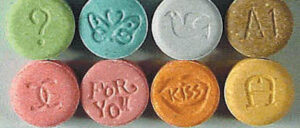
Ecstasy or ‘E’ as it is widely known is an amphetamine known as Methylene-dioxymethamphetamine (MDMA). It is a potent stimulant and mild hallucinogen. This drug is psychologically addictive, meaning that the user could become dependant on the high experienced with Ecstasy.
Ecstasy is known as the ‘designer drug’ of the nineties.
The tablets or capsules come in varying colours and sizes, the original being white with a peace dove on it. Many look similar to Panados. Ecstasy was originally patented back in 1914 as an appetite suppressant, the drug was never licensed and was banned in 1977 in the UK. Because ‘E’ is illegal, it may be ‘cut’ (mixed) with other substances (some of which are physically addictive) like LSD, tranquillizers, amphetamines and codeine (an opiate). Some are even mixed with heroin, cocaine, rat poison, as well as chalk, caffeine and aspirin.
Ecstasy is known as the “party/love/dance’’ drug and is popular at rave or trance parties where techno, house and trance music is played throughout the night. Users see, hear and feel things differently (hallucinations) and it makes the music more meaningful to them. It makes them feel energetic and increases staying power, which enables them to dance all night. People also use it when going out clubbing or to enhance sexual pleasure.
Also known as ‘E’, XTC, doves, love, Adam & Eve, pink Champagne, strawberry sundaes (due to colour), Dennis the Menace, snowballs, apples, Superman, Domes, White Diamonds and Mitsubishis.
How is it used?
Ecstasy is usually swallowed as a tablet or capsule (generally referred to as ‘pills’ by users) but it may be crushed and sniffed or dissolved in a liquid and then drunk.
Symptoms of Ecstasy use:
- Decrease in co-ordination
- Decreased appetite
- Decreased sleeping and resting
- Dilated (large) pupils
- Blurred vision
- Sweating
- Dry mouth
- Thirst
- Increased body temperature
- Muscle spasms
- Unsteadiness
- Jaw clenching and teeth grinding (This is why users often chew gum)
What are the effects of Ecstasy?
- Decreased inhibitions – the user will become adventurous and not think about the reasoning behind things
- Energetic
- Feeling of loving
- Feeling joyful, happy, peaceful
- Feeling sexual which may lead to risky sexual behaviour
- Dehydration (Users need to drink lots of water)
- Increased blood pressure and heart rate
- Mental illness
- Stiff muscles
- Breathing problems
- Fits
- Heat stroke
- Heart failure
- Delirium (e.g. Not knowing where they are)
- Coma
- Blood clotting
- Brain haemorrhages (bleeding on the brain)
- Hallucinations (seeing, hearing or feeling things that are not real)
- Death – there have been several recorded deaths due to dehydration or heat stroke as a result of using Ecstasy. This is because Ecstasy effects the part of the brain that regulates the need for water intake.
What are the long-term effects of Ecstasy use?
- Tolerance develops (The user will have to use more of the drug in order to get the same ‘high’)
- Damage to the brain and liver
- Death
- Depression which could lead to suicide
- Decreased immune system
- Sexually transmitted diseases due to high risk sexual behaviour (e.g. HIV/AIDS)
What happens when you STOP using Ecstasy?
- ‘Come down’ or withdrawal can last up to 24 hours but some of the effects mentioned below can last longer or may have a permanent effect
- Difficulty eating and sleeping
- Feeling ‘spaced out’ which is called ‘E-depression’
- Depression
- Paranoia
- Anxiety
